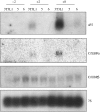Overexpression of Raidd cDNA inhibits differentiation of mouse preadipocytes
- PMID: 12558660
- PMCID: PMC6495696
- DOI: 10.1046/j.1365-2184.2003.00253.x
Overexpression of Raidd cDNA inhibits differentiation of mouse preadipocytes
Abstract
RAIDD (RIP-associated ICH-1 homologous protein with a death domain) is an adaptor molecule that mediates the action of cysteine proteases involved in apoptosis. To study the possibility of a novel system of cell ablation mediated by RAIDD, a preadipocyte cell line (3T3L1) was stably transfected with a plasmid containing the murine Raidd cDNA under the control of the adipocyte specific promoter aP2. Instead of the expected apoptosis, a blockage to differentiation upon hormonal induction was observed as judged by an absence of lipid accumulation, a lack of expression of adipocyte-specific genes and a fibroblastic appearance. Proliferation rate of Raidd-transfected clones remained unaffected. Overexpression of Raidd cDNA in 3T3L1 cell therefore inhibited differentiation, suggesting that Raidd plays a role in controlling differentiation of mouse preadipocytes and, perhaps, in other cell types, in addition to its established role in apoptosis.
Figures




Similar articles
-
In situ analysis of Raidd-beta-galactosidase fusion gene expression in transgenic mouse midgestation embryos.Transgenic Res. 2005 Feb;14(1):27-40. doi: 10.1007/s11248-004-2822-7. Transgenic Res. 2005. PMID: 15865046
-
Regulation of preadipocyte factor-1 gene expression during 3T3-L1 cell differentiation.Endocrinology. 1996 Jul;137(7):2923-8. doi: 10.1210/endo.137.7.8770915. Endocrinology. 1996. PMID: 8770915
-
Histone H4 proximal promoter mediates a complex transcriptional response during differentiation of 3T3L1 adipocytes.J Cell Physiol. 1995 May;163(2):312-20. doi: 10.1002/jcp.1041630212. J Cell Physiol. 1995. PMID: 7706376
-
Negative regulation of peroxisome proliferator-activated receptor-gamma gene expression contributes to the antiadipogenic effects of tumor necrosis factor-alpha.Mol Endocrinol. 1996 Nov;10(11):1457-66. doi: 10.1210/mend.10.11.8923470. Mol Endocrinol. 1996. PMID: 8923470
-
Characterization of Pref-1 and its inhibitory role in adipocyte differentiation.Int J Obes Relat Metab Disord. 1996 Mar;20 Suppl 3:S65-72. Int J Obes Relat Metab Disord. 1996. PMID: 8680480 Review.
Cited by
-
Non-apoptotic functions of apoptosis-regulatory proteins.EMBO Rep. 2012 Apr 2;13(4):322-30. doi: 10.1038/embor.2012.19. EMBO Rep. 2012. PMID: 22402666 Free PMC article. Review.
-
In situ analysis of Raidd-beta-galactosidase fusion gene expression in transgenic mouse midgestation embryos.Transgenic Res. 2005 Feb;14(1):27-40. doi: 10.1007/s11248-004-2822-7. Transgenic Res. 2005. PMID: 15865046
-
No death without life: vital functions of apoptotic effectors.Cell Death Differ. 2008 Jul;15(7):1113-23. doi: 10.1038/cdd.2008.28. Epub 2008 Feb 29. Cell Death Differ. 2008. PMID: 18309324 Free PMC article. Review.
References
-
- Birkenmeier EH, Gwynn B, Howard S, Jerry J, Gordon JI, Landschulz WH, McKnight SL (1989) Tissue‐specific expression, developmental regulation, and genetic mapping of the gene encoding CCAAT/enhancer binding protein. Genes Dev. 3, 1146. - PubMed
-
- Cao Z, Umek RM, McKnight SL (1991) Regulated expression of three C/EBP isoforms during adipose conversion of 3T3‐L1 cells, Genes Dev. 5, 1538. - PubMed
-
- Cook KS, Min HY, Johnson D, Chaplinsky RJ, Flier JS, Hunt CR, Spiegelman BM (1987) Adipsin: a circulating serine protease homolog secreted by adipose tissue and sciatic nerve. Science 237, 402. - PubMed
Publication types
MeSH terms
Substances
LinkOut - more resources
Full Text Sources
Molecular Biology Databases
Research Materials
Miscellaneous

